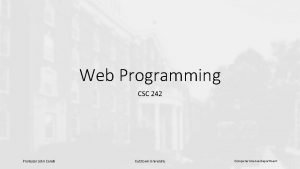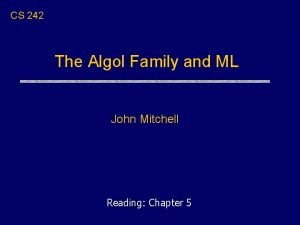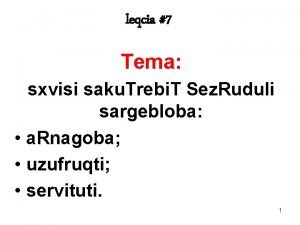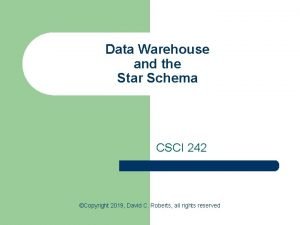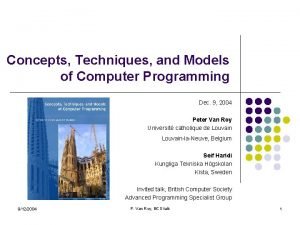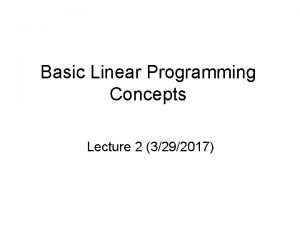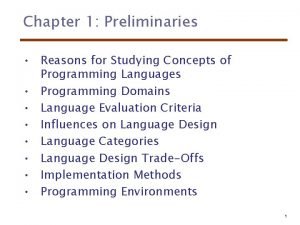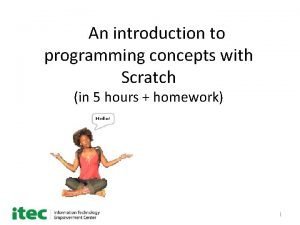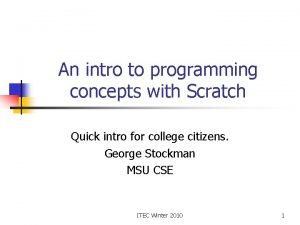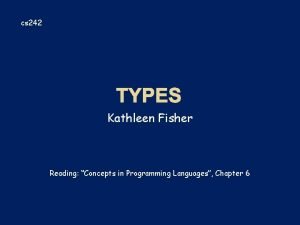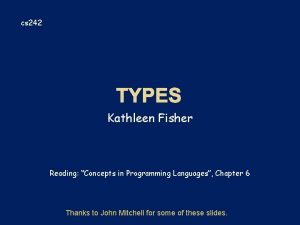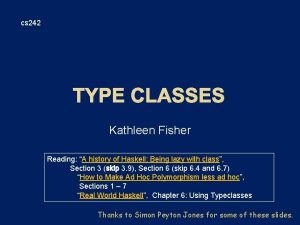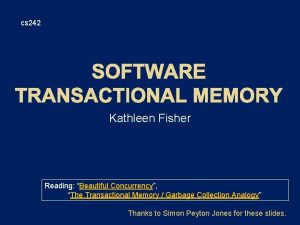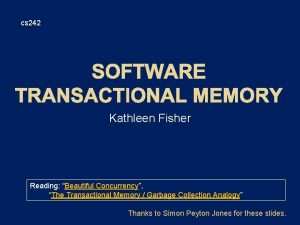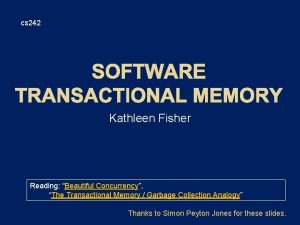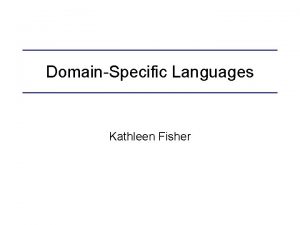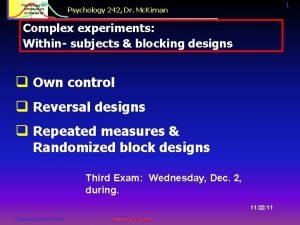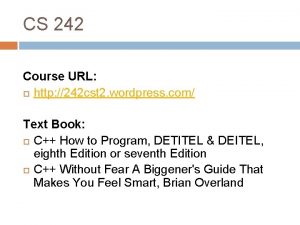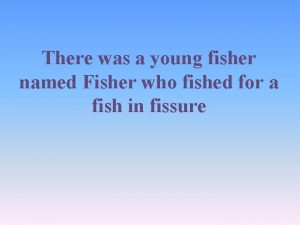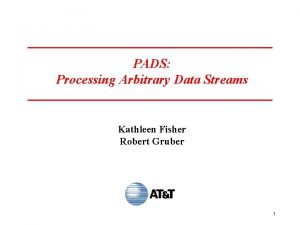cs 242 Kathleen Fisher Reading Concepts in Programming











![Array bounds part of type procedure illegal p(a : array [1. . 10] Array bounds part of type procedure illegal p(a : array [1. . 10]](https://slidetodoc.com/presentation_image_h/114c671e3beb88a883477dc4aeff8e07/image-12.jpg)














![Tuples (4, 5, “Griffendor”) : : (Integer, String) Lists [] : : [a] Tuples (4, 5, “Griffendor”) : : (Integer, String) Lists [] : : [a]](https://slidetodoc.com/presentation_image_h/114c671e3beb88a883477dc4aeff8e07/image-27.jpg)


![Apply function to every element of list map f [] = [] map Apply function to every element of list map f [] = [] map](https://slidetodoc.com/presentation_image_h/114c671e3beb88a883477dc4aeff8e07/image-30.jpg)
![Append lists append ([], ys) = ys (x: xs, ys) = x : Append lists append ([], ys) = ys (x: xs, ys) = x :](https://slidetodoc.com/presentation_image_h/114c671e3beb88a883477dc4aeff8e07/image-31.jpg)
![reverse xs = let rev ( [], accum ) = accum rev ( y: reverse xs = let rev ( [], accum ) = accum rev ( y:](https://slidetodoc.com/presentation_image_h/114c671e3beb88a883477dc4aeff8e07/image-32.jpg)













![No side effects. At all. reverse: : [w] -> [w] A call to reverse No side effects. At all. reverse: : [w] -> [w] A call to reverse](https://slidetodoc.com/presentation_image_h/114c671e3beb88a883477dc4aeff8e07/image-46.jpg)
![Purity makes the interface explicit. reverse: : [w] -> [w] -- Haskell Takes a Purity makes the interface explicit. reverse: : [w] -> [w] -- Haskell Takes a](https://slidetodoc.com/presentation_image_h/114c671e3beb88a883477dc4aeff8e07/image-47.jpg)

![Types are everywhere. reverse: : [w] -> [w] Usual static-typing panegyric omitted. . . Types are everywhere. reverse: : [w] -> [w] Usual static-typing panegyric omitted. . .](https://slidetodoc.com/presentation_image_h/114c671e3beb88a883477dc4aeff8e07/image-49.jpg)

- Slides: 50

cs 242 Kathleen Fisher Reading: “Concepts in Programming Languages” Chapter 5 except 5. 4. 5 “Real World Haskell”, Chapter 0 and Chapter 1 (http: //book. realworldhaskell. org/)

Algol 60 Lisp Algol 68 Pascal C Smalltalk ML Haskell Modula C++ Java Many other languages: Algol 58, Algol W, Euclid, EL 1, Mesa (PARC), Modula-2, Oberon, Modula-3 (DEC), …

Basic Language of 1960 Simple imperative language + functions Successful syntax, BNF -- used by many successors statement oriented begin … end blocks (like C/Java { … } ) if … then … else Recursive functions and stack storage allocation Fewer ad hoc restrictions than Fortran General array references: A[ x + B[3] * y ] Type discipline was improved by later languages Very influential but not widely used in US Tony Hoare: “Here is a language so far ahead of its time that it was not only an improvement on its predecessors but also on nearly all of its successors. ”

real procedure average(A, n); real array A; integer n; begin real sum; sum : = 0; for i = 1 step 1 until n do sum : = sum + A[i]; average : = sum/n end; No array bounds. No “; ” here. Set procedure return value by assignment.

Question: Is x : = x equivalent to doing nothing? Interesting answer in Algol: integer procedure p; begin …. p : = p …. end; Assignment here is actually a recursive call!

Holes in type discipline Parameter types can be arrays, but No array bounds Parameter types can be procedures, but No argument or return types for procedure parameters Some awkward control issues goto out of block requires memory management Problems with parameter passing mechanisms Pass-by-name “Copy rule” duplicates code, interacting badly with side effects Pass-by-value expensive for arrays

Substitute text of actual parameter Unpredictable with side effects! Example procedure inc 2(i, j); integer i, j; begin i : = i+1; j : = j+1 end; begin k : = k+1; A[k] : = A[k] +1 end; inc 2 (k, A[k]); Is this what you expected?

Fixed some problems of Algol 60 Eliminated pass-by-name Considered difficult to understand Idiosyncratic terminology Types were called “modes” Arrays were called “multiple values” Used v. W grammars instead of BNF Context-sensitive grammar invented by van Wijngaarden Elaborate type system Complicated type conversions Not widely adopted Adriaan van Wijngaarden

Primitive modes int real char bool string compl (complex) bits bytes sema (semaphore) format (I/O) file § Compound modes § § § arrays structures procedures sets pointers Rich, structured, and orthogonal type system is a major contribution of Algol 68.

Storage management Local storage on stack Heap storage, explicit alloc, and garbage collection Parameter passing Pass-by-value Use pointer types to obtain pass-by-reference Assignable procedure variables Follow “orthogonality” principle rigorously A Tutorial on Algol 68 by Andrew S. Tanenbaum

Designed by Niklaus Wirth (Turing Award) Revised the type system of Algol Good data-structuring concepts records, variants, subranges More restrictive than Algol 60/68 Procedure parameters cannot have higher-order procedure parameters Popular teaching language Simple one-pass compiler Niklaus Wirth
![Array bounds part of type procedure illegal pa array 1 10 Array bounds part of type procedure illegal p(a : array [1. . 10]](https://slidetodoc.com/presentation_image_h/114c671e3beb88a883477dc4aeff8e07/image-12.jpg)
Array bounds part of type procedure illegal p(a : array [1. . 10] of integer) p(n: integer, a : array [1. . n] of integer) Attempt at orthogonal design backfires – Parameter must be given a type – Type cannot contain variables How could this have happened? Emphasis on teaching? § Not successful for “industrial-strength” projects § Kernighan: “Why Pascal is not my favorite language” § Left niche for C; niche has expanded!!

Designed by Dennis Ritchie, Turing Award winner, for writing Unix Evolved from B, which was based on BCPL B was an untyped language; C adds some checking Relationship between arrays and pointers An array is treated as a pointer to first element E 1[E 2] is equivalent to ptr dereference: *((E 1)+(E 2)) Pointer arithmetic is not common in other languages Ritchie quote “C is quirky, flawed, and a tremendous success. ”

ML Statically typed, general-purpose programming language Type safe! Compiled language, but intended for interactive use Combination of Lisp and Algol-like features Expression-oriented Higher-order functions Garbage collection Abstract data types Module system Exceptions Designed by Turing-Award winner Robin Milner for LCF Theorem Prover Used in textbook as example language

Haskell is a programming language that is Similar to ML: general-purpose, strongly typed, higher-order, functional, supports type inference, supports interactive and compiled use Different from ML: lazy evaluation, purely functional core, rapidly evolving type system. Designed by committee in 80’s and 90’s to unify research efforts in lazy languages. Haskell 1. 0 in 1990, Haskell ‘ 98, Haskell’ ongoing. “A History of Haskell: Being Lazy with Class” HOPL 3 Paul Hudak John Hughes Simon Peyton Jones Phil Wadler

Good vehicle for studying language concepts Types and type checking General issues in static and dynamic typing Type inference Parametric polymorphism Ad hoc polymorphism Control Lazy vs. eager evaluation Tail recursion and continuations Precise management of effects

Functional programming will make you think differently about programming. Mainstream languages are all about state Functional programming is all about values Ideas will make you a better programmer in whatever language you regularly use. Haskell is “cutting edge. ” A lot of current research is done in the context of Haskell.

Practitioners 1, 000 10, 000 Geeks 100 The quick death 1 1 yr 5 yr 10 yr 15 yr

Practitioners 1, 000 10, 000 Geeks 100 The slow death 1 1 yr 5 yr 10 yr 15 yr

Practitioners Threshold of immortality 1, 000 10, 000 The complete absence of death Geeks 100 1 1 yr 5 yr 10 yr 15 yr

Practitioners 1, 000 10, 000 Geeks 100 The slow death 1 1 yr 5 yr 10 yr 15 yr

Practitioners 1, 000 “I'm already looking at coding problems and my mental perspective is now shifting back and forth between purely OO and more FP styled solutions” (blog Mar 2007) 10, 000 100 Geeks “Learning Haskell is a great way of training yourself to think functionally so you are ready to take full advantage of C# 3. 0 when it comes out” (blog Apr 2007) The second life? 1 1990 1995 2000 2005 2010

In Haskell, f : : A B means for every x A, f(x) = some element y = f(x) B run forever In words, “if f(x) terminates, then f(x) B. ” In ML, functions with type A B can throw an exception, but not in Haskell.

Functions that take other functions as arguments or return as a result are higher-order functions. Common Examples: Map: applies argument function to each element in a collection. Reduce: takes a collection, an initial value, and a function, and combines the elements in the collection according to the function. list = [1, 2, 3] r = foldl (accumulator i -> i + accumulator) 0 list Google uses Map/Reduce to parallelize and distribute massive data processing tasks. (Dean & Ghemawat, OSDI 2004)

Interactive Interpreter (ghci): read-eval-print ghci infers type before compiling or executing Type system does not allow casts or other loopholes! Examples Prelude> (5+3)-2 6 it : : Integer Prelude> if 5>3 then “Harry” else “Hermione” “Harry” it : : [Char] -- String is equivalent to [Char] Prelude> 5==4 False it : : Bool

Booleans True, False : : Bool if … then … else … --types must match Integers 0, 1, 2, … : : Integer +, * , … : : Integer -> Integer Strings “Ron Weasley” Floats 1. 0, 2, 3. 14159, … --type classes to disambiguate Haskell Libraries
![Tuples 4 5 Griffendor Integer String Lists a Tuples (4, 5, “Griffendor”) : : (Integer, String) Lists [] : : [a]](https://slidetodoc.com/presentation_image_h/114c671e3beb88a883477dc4aeff8e07/image-27.jpg)
Tuples (4, 5, “Griffendor”) : : (Integer, String) Lists [] : : [a] -- polymorphic type 1 : [2, 3, 4] : : [Integer] -- infix cons notation Records data Person = Person {first. Name : : String, last. Name : : String} hg = Person { first. Name = “Hermione”, last. Name = “Granger”}

Patterns can be used in place of variables <pat> : : = <var> | <tuple> | <cons> | <record> … Value declarations General form <pat> = <exp> Examples my. Tuple = (“Flitwick”, “Snape”) (x, y) = my. Tuple my. List = [1, 2, 3, 4] z: zs = my. List Local declarations let (x, y) = (2, “Snape”) in x * 4

Anonymous function x -> x+1 --like Lisp lambda, function (…) in JS Declaration form <name> <pat 1> = <exp 1> <name> <pat 2> = <exp 2> … <name> <patn> = <expn> … Examples f (x, y) = x+y --actual parameter length [] = 0 length (x: s) = 1 + length(s) must match pattern (x, y)
![Apply function to every element of list map f map Apply function to every element of list map f [] = [] map](https://slidetodoc.com/presentation_image_h/114c671e3beb88a883477dc4aeff8e07/image-30.jpg)
Apply function to every element of list map f [] = [] map f (x: xs) = f x : map f xs map (x -> x+1) [1, 2, 3] [2, 3, 4] Compare to Lisp (define map (lambda (f xs) (if (eq? xs ()) () (cons (f (car xs)) ))) (map f (cdr xs)))
![Append lists append ys ys x xs ys x Append lists append ([], ys) = ys (x: xs, ys) = x :](https://slidetodoc.com/presentation_image_h/114c671e3beb88a883477dc4aeff8e07/image-31.jpg)
Append lists append ([], ys) = ys (x: xs, ys) = x : append (xs, ys) Reverse a list reverse [] = [] (x: xs) = (reverse xs) ++ [x] Questions How efficient is reverse? Can it be done with only one pass through list?
![reverse xs let rev accum accum rev y reverse xs = let rev ( [], accum ) = accum rev ( y:](https://slidetodoc.com/presentation_image_h/114c671e3beb88a883477dc4aeff8e07/image-32.jpg)
reverse xs = let rev ( [], accum ) = accum rev ( y: ys, accum ) = rev ( ys, y: accum ) in rev ( xs, [] ) 1 3 2 2 3 3 1 3 2 2 1 1

Notation for constructing new lists from old: my. Data = [1, 2, 3, 4, 5, 6, 7] twice. Data = [2 * x | x <- my. Data] -- [2, 4, 6, 8, 10, 12, 14] twice. Even. Data = [2 * x| x <- my. Data, x `mod` 2 == 0] -- [4, 8, 12]

Examples data Color = Red | Yellow | Blue elements are Red, Yellow, Blue data Atom = Atom String | Number Int elements are Atom “A”, Atom “B”, …, Number 0, . . . data List = Nil | Cons (Atom, List) elements are Nil, Cons(Atom “A”, Nil), … Cons(Number 2, Cons(Atom(“Bill”), Nil)), . . . General form data <name> = <clause> | … | <clause> : : = <constructor> | <contructor> <type> Type name and constructors must be Capitalized.

Recursively defined data structure data Tree = Leaf Int | Node (Int, Tree) Node(4, Node(3, Leaf 1, Leaf 2), Node(5, Leaf 6, Leaf 7)) 4 Recursive function 3 1 5 2 sum (Leaf n) = n sum (Node(n, t 1, t 2)) = n + sum(t 1) + sum(t 2) 6 7

Define datatype of expressions data Exp = Var Int | Const Int | Plus (Exp, Exp) Write (x+3)+ y as Plus(Var 1, Const 3), Var 2) Evaluation function ev(Var n) = Var n ev(Const n ) = Const n ev(Plus(e 1, e 2)) = … Examples ev(Plus(Const 3, Const 2)) Const 5 ev(Plus(Var 1, Plus(Const 2, Const 3))) Plus(Var 1, Const 5)

Datatype data Exp = Var Int | Const Int | Plus (Exp, Exp) § Case expression case e of Var n -> … Const n -> … Plus(e 1, e 2) -> … Indentation matters in case statements in Haskell.

data Exp = Var Int | Const Int | Plus (Exp, Exp) ev ( Var n) = Var n ev ( Const n ) = Const n ev ( Plus ( e 1, e 2 ) ) = case ev e 1 of Var n -> Plus( Var n, ev e 2) Const n -> case ev e 2 of Var m -> Plus( Const n, Var m) Const m -> Const (n+m) Plus(e 3, e 4) -> Plus ( Const n, Plus ( e 3, e 4 )) Plus(e 3, e 4) -> Plus( Plus ( e 3, e 4 ), ev e 2)

Haskell is a lazy language Functions and data constructors don’t evaluate their arguments until they need them. cond : : Bool -> a cond True t e = t cond False t e = e Programmers can write control-flow operators that have to be built-in in eager languages. Shortcircuiting “or” (||) : : Bool -> Bool True || x = True False || x = x

is. Sub. String : : String -> Bool x `is. Sub. String` s = or [ x `is. Prefix. Of` t | t <- suffixes s ] suffixes: : String -> [String] -- All suffixes of s suffixes[] = [[]] suffixes(x: xs) = (x: xs) : suffixes xs or -or or type String = [Char] : : [Bool] -> Bool (or bs) returns True if any of the bs is True [] = False (b: bs) = b || or bs

Generate all solutions (an enormous tree) Walk the tree to find the solution you want next. Move : : Board -> Move next. Move b = select. Move all. Moves where all. Moves = all. Moves. From b A gigantic (perhaps infinite) tree of possible moves

Basic Types Unit Booleans Integers Strings Reals Tuples Lists Records § § § § Patterns Declarations Functions Polymorphism Type declarations Type Classes Monads Exceptions

§ Available on Stanford pod cluster § Handout on course web site on how to use. Or, download: http: //haskell. org/ghc Interactive: ghci intro. hs Compiled: ghc –make Algol. And. Haskell. hs Demo ghci

It’s good to write tests as you write code E. g. reverse undoes itself, etc. reverse xs = let rev ( [], z ) = z rev ( y: ys, z ) = rev( ys, y: z ) in rev( xs, [] ) -- Write properties in Haskell type TS = [Int] -- Test at this type prop_Rev. Rev : : TS -> Bool prop_Rev. Rev ls = reverse (reverse ls) == ls

Test. Quick. Check is simply a Haskell library (not a “tool”) bash$ ghci intro. hs Prelude> : m +Test. Quick. Check Prelude Test. Quick. Check> quick. Check prop_Rev. Rev +++ OK, passed 100 tests . . . with a strangelooking type Prelude Test. Quick. Check> : t quick. Check : : Testable prop => prop -> IO () Demo Quick. Check
![No side effects At all reverse w w A call to reverse No side effects. At all. reverse: : [w] -> [w] A call to reverse](https://slidetodoc.com/presentation_image_h/114c671e3beb88a883477dc4aeff8e07/image-46.jpg)
No side effects. At all. reverse: : [w] -> [w] A call to reverse returns a new list; the old one is unaffected. prop_Rev. Rev l = reverse(reverse l) == l A variable ‘l’ stands for an immutable value, not for a location whose value can change. Laziness forces this purity.
![Purity makes the interface explicit reverse w w Haskell Takes a Purity makes the interface explicit. reverse: : [w] -> [w] -- Haskell Takes a](https://slidetodoc.com/presentation_image_h/114c671e3beb88a883477dc4aeff8e07/image-47.jpg)
Purity makes the interface explicit. reverse: : [w] -> [w] -- Haskell Takes a list, and returns a list; that’s all. void reverse( list l ) /* C */ Takes a list; may modify it; may modify other persistent state; may do I/O.

Pure functions are easy to test. prop_Rev. Rev l = reverse(reverse l) == l In an imperative or OO language, you have to set up the state of the object and the external state it reads or writes make the call inspect the state of the object and the external state perhaps copy part of the object or global state, so that you can use it in the post condition
![Types are everywhere reverse w w Usual statictyping panegyric omitted Types are everywhere. reverse: : [w] -> [w] Usual static-typing panegyric omitted. . .](https://slidetodoc.com/presentation_image_h/114c671e3beb88a883477dc4aeff8e07/image-49.jpg)
Types are everywhere. reverse: : [w] -> [w] Usual static-typing panegyric omitted. . . In Haskell, types express high-level design, in the same way that UML diagrams do, with the advantage that the type signatures are machine -checked. Types are (almost always) optional: type inference fills them in if you leave them out.

The Haskell wikibook http: //en. wikibooks. org/wiki/Haskell All the Haskell bloggers, sorted by topic http: //haskell. org/haskellwiki/Blog_articles Collected research papers about Haskell http: //haskell. org/haskellwiki/Research_papers Wiki articles, by category http: //haskell. org/haskellwiki/Category: Haskell Books and tutorials http: //haskell. org/haskellwiki/Books_and_tutorials
 Kathleen fisher cerner
Kathleen fisher cerner While reading activities
While reading activities Kj 242
Kj 242 Gezang 239
Gezang 239 49 cfr part 242
49 cfr part 242 Santa paz e alegria la no ceu vou desfrutar
Santa paz e alegria la no ceu vou desfrutar He 242
He 242 Carelli kutztown
Carelli kutztown Ac network theorems
Ac network theorems Cs 242
Cs 242 Strp manulife
Strp manulife Sxvisi svili
Sxvisi svili Step ap 242
Step ap 242 Et 242
Et 242 Schema 242
Schema 242 Hibbeler
Hibbeler I^242
I^242 Is-242.b
Is-242.b Fpunity
Fpunity Concepts techniques and models of computer programming
Concepts techniques and models of computer programming Linear programming basic concepts
Linear programming basic concepts Reasons for studying concepts of programming languages
Reasons for studying concepts of programming languages Scratch programming concepts
Scratch programming concepts Scratch programming concepts
Scratch programming concepts Perbedaan linear programming dan integer programming
Perbedaan linear programming dan integer programming Greedy programming vs dynamic programming
Greedy programming vs dynamic programming What is in system programming
What is in system programming Linear vs integer programming
Linear vs integer programming Definisi linear
Definisi linear Kathleen gasparian
Kathleen gasparian Dame kathleen ollerenshaw fellowship
Dame kathleen ollerenshaw fellowship Kathleen merikangas
Kathleen merikangas Kathleen quinlan coma
Kathleen quinlan coma Kathleen cotton classroom questioning
Kathleen cotton classroom questioning Kathleen vanin
Kathleen vanin Kathleen quinlan measurements
Kathleen quinlan measurements Classroom questioning kathleen cotton
Classroom questioning kathleen cotton Kathleen kelly character
Kathleen kelly character Kathleen maddox
Kathleen maddox Kathleen brehony
Kathleen brehony Kathleen byington
Kathleen byington Kathleen hermsmeyer
Kathleen hermsmeyer Kathleen stassen berger
Kathleen stassen berger Innovatiepremie
Innovatiepremie Kathleen hill uwo
Kathleen hill uwo Kathleen durant rate my professor
Kathleen durant rate my professor Kathleen armour
Kathleen armour Kathleen bieschke
Kathleen bieschke Mrs merv grazinski
Mrs merv grazinski Kathleen heneghan
Kathleen heneghan Kathleen okruhlik
Kathleen okruhlik







